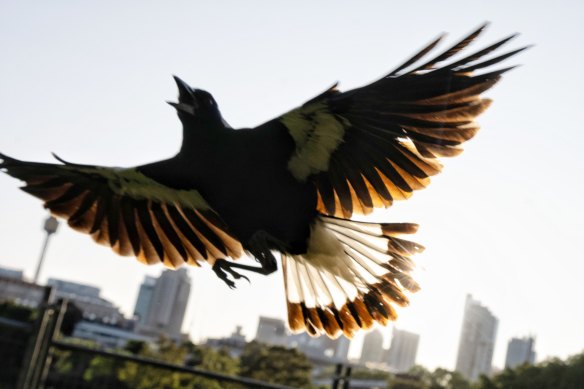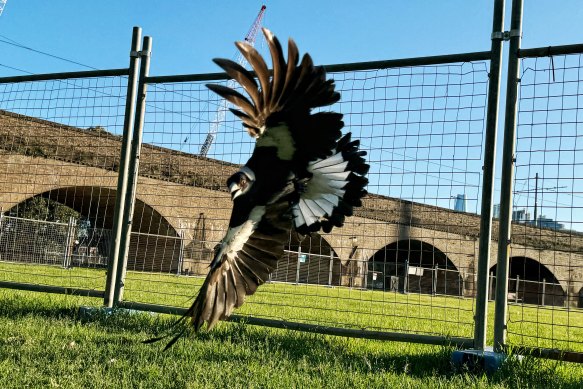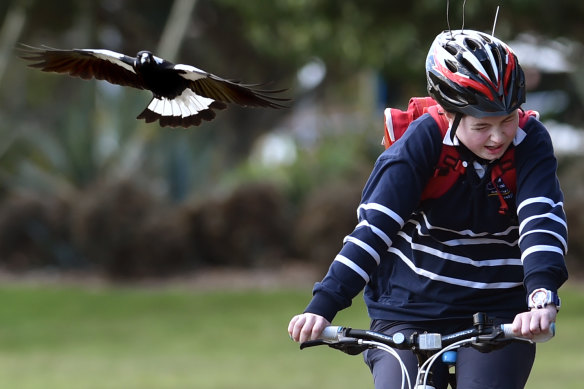
Save articles for later
Add articles to your saved list and come back to them any time.
With a seemingly unpredictable striking style and a burst of staccato beak snaps, a swooping magpie can send unsuspecting suburban strollers sprinting for cover.
Swooping season kicks off in late September and does not relent until early November.
A swooping magpie in Wentworth Park.Credit: Nick Moir
The brood defenders have been spotted from Coogee to Leura, according to swoop reporting site Magpie Alert!, although the swoops usually do not make contact and rarely cause injury.
Griffith University Emeritus Professor Darryl Jones said enough is known about their biology, behaviour and evolution to help avoid, and empathise with, the attacking magpies.
Why magpies swoop
“There were so many reasons people thought they might be attacking us, from they hate the colour purple to they were collecting hair for their nests,” said Jones, an urban ecologist who has researched magpie swoops since the ’80s.
Over years of research, Jones has disproved theories that magpies swooped due to spiking testosterone or a distaste for lilac. The most obvious hypothesis was true – they’re defending chicks. Once baby magpies leave the nest, the swooping stops.
Only about 10 per cent of magpies, mostly males, are aggressive once their chicks hatch.
“What we don’t understand is why certain individual birds become obsessed with people, because as far as I know, none of the people who get swooped every year have climbed a tree and eaten a baby magpie,” Jones said.
“Clearly, they must have a really low threshold of what they regard as a threat.”
Aggression intensifies over the season for two reasons.
“At the beginning of the season, a magpie gives a really specific call that says, ‘Hey, I can see you coming towards my nest, keep away’. That’s a call that we don’t recognise because we’re not magpies.”
Faced with an ongoing procession of pedestrians and cyclists, the magpies up the ante to warning swoops well above people’s heads, which also goes unnoticed.
“By the end of the season, they’ve done this hundreds of times, and they’re absolutely exasperated. That’s when they start making contact.”
Magpies only swoop for the short period of time their chicks are in the nest.Credit: Nick Moir
The second reason is that chicks are more evolutionary valuable as they grow because the parents have poured so much energy into their care.
Later in the season, there’s also less time to have a second brood if the first doesn’t survive, so magpies go to greater ends to defend their chicks as the end of spring approaches.
How to avoid an attacking magpie
Jones said magpies are stealth bombers and less likely to attack from the front.
Back away calmly and don’t run or wave your arms, which could exacerbate the aggression. A magpie may defend a 100-metre area around its nest.
Wearing a hat and sunglasses for protection is sensible, Jones said, but slapping fake googly eyes on the back of a helmet does not work.
If you’re on a bicycle, step off and walk from the area near the nest.Credit: Steven Siewert
“Magpies are very smart. If they can recognise facial features on humans, what are they going to think about a circle with a dot in it? That’s just ridiculous,” Jones said.
Magpies can memorise about 20 faces, so if you live near a swooping magpie, there’s a chance you can negotiate a truce.
“You can turn an aggressive magpie into a peaceful one, by so-called befriending it and providing food. But it only happens for a person who lives within the territory of a magpie. There’s no way you can do that down at a busy park that hundreds of people walk through every day.”
In extreme cases, a problem magpie can be relocated, and Jones’ research shows it’s unlikely to return if transported more than 70 kilometres away.
That leaves the chicks and mother at risk. But competition for females and territory is so high, often a new male will appear within hours and take up fatherly duties, Jones said.
“We found that the stepfathers feed the cheeks at twice the rate of the original male. We think that’s because he’s trying desperately to prove to the female that he’s going to be a good stepfather, and the next time they have chicks over the years he’ll be able to stay.”
Magpie numbers are on the decline. An analysis of BirdLife Australia data showed sightings decreased by more than 30 per cent between 1998 and 2013 in eastern Australia, including Sydney.
The Examine newsletter explains and analyses science with a rigorous focus on the evidence. Sign up to get it each week.
Most Viewed in National
From our partners
Source: Read Full Article


